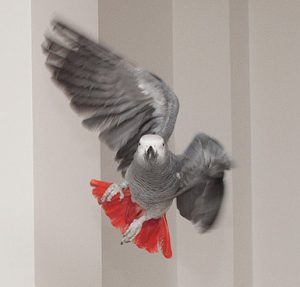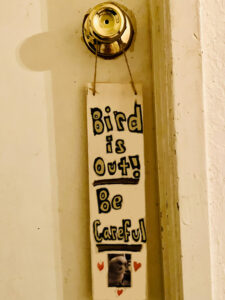
Allowing your parrot to fly around can be incredibly beneficial. It offers essential exercise that maintains cardiovascular health. Flying and navigating around a room can stimulate your bird’s mind, and teaching your bird to fly to you can strengthen your bond. However, ensuring your home is safe for a free-flying parrot involves careful planning and adjustments to prevent accidents and avoid unnecessary risks. Here are some essential tips to create a safe flight path for your feathered family member.
Secure Doors & Windows
A sad fact is that most companion parrots don’t stand much of a chance outdoors on their own. They are up against stealthy predators like hawks and cats, and they are unlikely to find food sources. An “escaped parrot” can be a misnomer; that wording can be interpreted as a pet parrot fleeing their home. A “lost parrot” is more likely the case — a parrot found their way outside through an open door or window, and now they are on high alert, and unfamiliar sights or sounds cause them to take off, not knowing where they’re going.
When your bird is out of their cage, windows should be shut or frequently monitored if they have screens. Parrots big and small can chew through a screen, so don’t let a windowscreen or door screen give you a false sense of security.
Birds-vs-glass-building collisions in the wild are more common than we like to think, especially for migrating birds, and they are often deadly. Pet birds inside a home can also fly into a window. Help your bird recognize window glass as the barrier it is by putting a decal or other visual on and around it so they don’t accidentally fly into it.
Doors are a bit trickier, as they are more frequently opened and closed, which presents two potential hazards: 1. Your bird gets outside through an opened door; 2. Your bird gets injured if caught in a door as it is being closed. Sadly, birds have died after being caught in a slammed door, either because their person didn’t see them coming or the person hastily shut a door as they saw their bird flying toward it and the timing was ill-fated.
Use Areas Suited For Flight
The safest area of your home for a fully flighted bird is one where a door can be more easily monitored and perhaps less frequently opened and closed, such as a dedicated bird room, office, or bedroom. Areas adjacent to your home’s front door or that lead to a backyard, like living rooms and dens, not only are “one door away” from the great outdoors but are more likely to be opened as people come and go.
Areas with easy access to the kitchen also require more diligence so your bird doesn’t fly onto a hot stove or boiling pot of water. Be diligent with bathrooms, too. Birds can drown if they fall into an open-lid toilet or a drawn bath.
See The Signs

Image courtesy Laura Doering
If your feathered friend is fully flighted, grab your pens and markers to make things extra safe. Whenever your bird enjoys their free-flight time, put up a sign that says so. A do-not-disturb sign, like those put on hotel room doors, is perfect to hang on the door handle of your bird’s fly space. You can find blank wood do-not-disturb door handle signs at arts and crafts stores and online, or make one out of cardboard. If you’re crafty, make your next cross-stitch project a bird sign. The goal is to get the point across for anyone entering your bird’s free-flight area to activate their “birdie safety sense” before entering.
Even if you are home alone, a sign will remind you that your free-flying feathered friend is out in the room. For an extra line of defense, put one on your front doorknob or backdoor handle to prevent you from walking outside while forgetting that your bird is on your shoulder — it happens!
No matter how many cute videos exist online, a ceiling fan should not be used as a bird merry-go-round. A flighted bird can become seriously injured if they collide with a moving ceiling fan. This might be another sign (or sticker/label) to put up — one near the ceiling fan switch to remind you and others not to turn the fan on while your bird is out.

Want another line of defense? Install bamboo or beaded curtains in a hallway or doorway to prevent your bird from flying into areas they shouldn’t be. At the very least, it will slow down their flight, turn their flight around, or cause them to pause if they land on the curtain beads, giving you time to redirect them back to a safer area. Unless you know for certain, assume that those curtain beads are not safe for your bird to chew on; this isn’t a hangout spot but rather a way to stop a bird’s wayward flight path.
No matter how many cute videos exist online, a ceiling fan should not be used as a bird merry-go-round. A flighted bird can become seriously injured if they collide with a moving ceiling fan. This might be another sign to put up — one near the ceiling fan switch to remind you and others not to turn the fan on while your bird is out.
Make sure your fully flighted feathered friend (try saying that 10 times in a row!) has safe landing spots, such as a tree gym or tabletop perch. If you are one of your bird’s landing spots, offer a steady arm for them to fly to. Some parrots like to return to the top of their cage. No matter how long your parrot will be in full flight mode, leave the cage door open so they can go back inside to eat, sip water, or chill out.
End free-flight time on a happy note, and offer your parrot a treat as you bring them back to their cage. Resist chasing after your bird or handling them aggressively if they have a different opinion about when to go back to the cage. Teach your feathered friend to fly to you, which is a form of target training. A simple way to get started is to offer a favorite treat from your hand while holding a perch or stick for them to step up on. Start close and increase the distance incrementally so your bird flitters over to you and ultimately flies to you from across the room. Use a cue word, such as an encouraging, “Come hear,” and always be respectful and patient.
Is your bird ready to fly or want to learn more about birds and flying? Here’s an informative article on birds and flight by esteemed veterinarian Susan Orosz, PhD, DVM, Dipl ABVP (Avian), Dipl ECZM (Avian).

Thiss iss a topic that iis ner too mmy heart… Best wishes!
Exactly where are yojr contaact detais though?